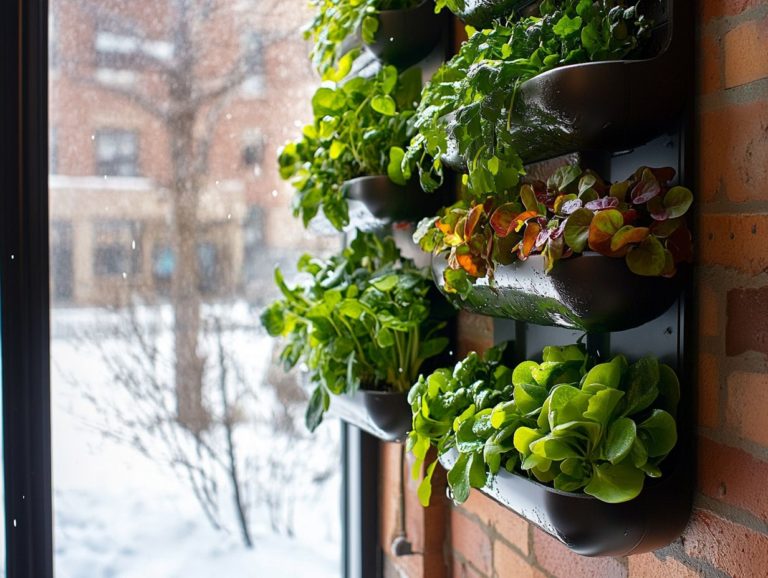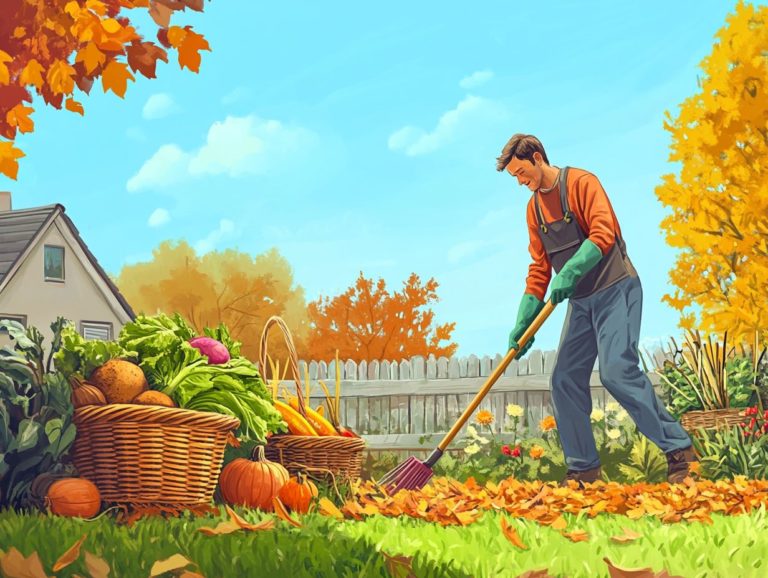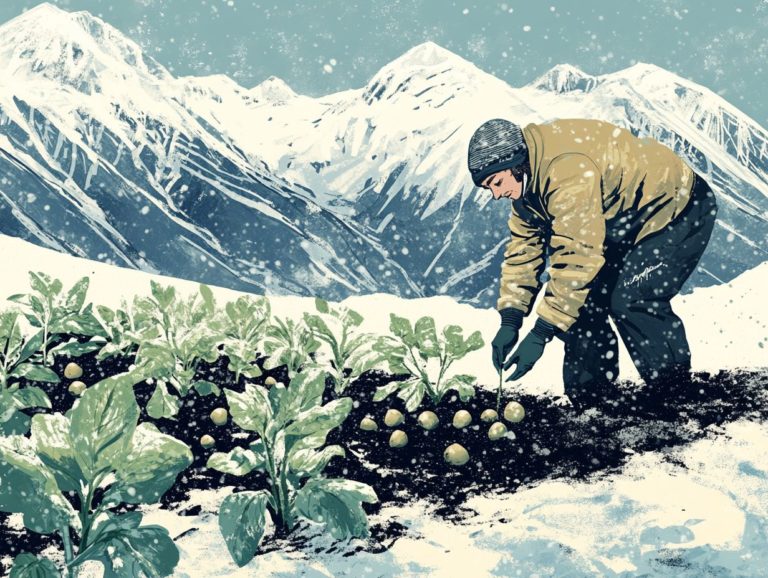How to Grow a Winter Salad Garden?
Growing a winter salad garden offers a delightful opportunity to savor fresh, vibrant greens throughout the chilly months.
Start your winter salad garden now and enjoy fresh produce even when it’s cold outside! By selecting the right mix of cold-hardy vegetables and herbs, you can cultivate a flourishing garden that enhances your winter meals and keeps your passion for gardening flourishing.
This guide will walk you through choosing the best plants, preparing your garden for the winter, and maintaining your crop for a plentiful harvest. You will discover exciting recipes to make the most of your winter greens!
Contents
- Key Takeaways:
- Benefits of Growing a Winter Salad Garden
- Choosing the Right Plants
- Preparing Your Garden for Winter
- Planting and Maintaining a Winter Salad Garden
- Harvesting and Storing Winter Salad Greens
- Creative Ways to Use Winter Salad Greens
- Frequently Asked Questions
- What are the benefits of growing a winter salad garden?
- When should I start planting my winter salad garden?
- What types of vegetables can I include in my winter salad garden?
- Do I need any special equipment to grow a winter salad garden?
- How often should I water my winter salad garden?
- Can I harvest from my winter salad garden throughout the winter?
Key Takeaways:

- Extend your gardening season by planting a winter salad garden for fresh, nutrient-rich greens all year round.
- Choose cold-hardy vegetables and herbs, such as kale, arugula, and chives, to withstand the colder temperatures.
- Keep your winter salad garden thriving by protecting plants from frost and using these tips for a successful growth and harvest.
Benefits of Growing a Winter Salad Garden
Growing a winter salad garden presents a wealth of benefits, allowing you to enjoy fresh, homegrown vegetables even in the chillier months. For specific advice, check out these tips for growing microgreens in winter.
Cultivating cold-hardy greens like lettuce, spinach, and arugula establishes a sustainable source of nutrition. This practice boosts your health and well-being.
Furthermore, winter gardening encourages organic practices, minimizes the carbon footprint linked to store-bought produce, and deepens your connection to nature during a season often marked by dormancy. With thoughtful planning and the right techniques, your winter garden can flourish, offering you vibrant, local greens all year round.
Choosing the Right Plants
Pick the right plants to unlock a bountiful winter harvest! Selecting the right plants for your winter salad garden is crucial for enjoying a plentiful yield during the colder months. Focus on cold-hardy vegetables like Winter Density and Buttercrunch lettuce, as well as nutrient-rich greens such as spinach and arugula, which thrive even in lower temperatures. For more insights, check out these tips for sustainable winter gardening.
Don t overlook a group of vegetables called brassicas, which includes Mizuna and M che; they not only add unique flavors but are also frost-resistant. By carefully selecting plants that suit your local climate and soil conditions, you can cultivate a diverse and productive winter garden that will keep your salads fresh and exciting.
Cold-Hardy Vegetables and Herbs
Cold-hardy vegetables and herbs are essential when you’re establishing a winter salad garden, allowing you to savor fresh greens even in the chill of winter. Think of varieties like Winter Purslane, Black-Seeded Simpson, and Claytonia; these robust plants thrive in harsh conditions. Additionally, if you’re interested in expanding your garden, consider learning how to successfully grow garlic in winter.
Not only do they pack a nutritional punch, but they also require minimal protection, making them perfect for any gardener eager to extend their harvest during the colder months. By understanding their hardiness and the right cultivation techniques, you can achieve gardening success even in frost-prone areas.
Along with those, consider exploring various kale varieties and hearty herbs like thyme and parsley, both of which demonstrate impressive resilience in colder temperatures. When you cultivate these plants, be sure to take their specific hardiness zones into account, typically ranging from zones 3 to 7, to ensure their growth is successful.
Implementing simple protection measures like row covers that trap heat and shield against frost or a greenhouse for the more delicate varieties can significantly boost their development. Don’t forget that regular monitoring of soil moisture and ensuring adequate drainage are also critical. By keeping these aspects in check, you’re setting the stage for a truly bountiful winter harvest.
In summary, embrace the joys of winter gardening and enjoy the fresh, nutritious produce it brings!
Preparing Your Garden for Winter

Preparing your garden for winter is essential for a thriving winter salad garden. Choose a sunny spot with southern exposure to capture the maximum sunlight.
Enrich your soil with organic matter to improve drainage and boost nutrients. Your plants will flourish with better soil health.
Use techniques like succession planting and protective measures such as row covers or greenhouses. These strategies can strengthen your winter crops.
Protecting Plants from Frost and Cold
Protect your plants from frost and cold to ensure they thrive. Covers like floating row covers or cold frames create a shield against harsh conditions and help retain moisture.
Understand the needs of hardy vegetables, including temperature ranges and moisture levels. This knowledge helps you develop effective protection strategies based on your climate.
Layering techniques can also boost resilience. Use mulch or straw to insulate the soil and support beneficial microbes that enhance nutrient availability.
Adjust your watering during winter. Keep soil moisture steady to promote healthy roots and reduce frost damage.
Combining these methods creates a nurturing environment for your plants, even in the coldest months.
Planting and Maintaining a Winter Salad Garden
Cultivating a winter salad garden requires careful planning. For the best results, check out how to plan a cold-climate vegetable garden and start planting cold-hardy varieties in early autumn.
Implement succession planting for a continuous harvest. Effective watering practices are crucial for maintaining moisture for seedlings.
Transplant seedlings at the right time to enhance winter resilience. This approach prepares your garden for a bountiful yield.
Tips for Successful Growth and Harvest
To achieve a thriving winter salad garden, use effective techniques such as learning how to winterize your garden. Monitor soil moisture and adopt proper watering methods for optimal growing conditions.
Apply organic fertilizers to enrich the soil, promoting growth and improving the quality of your greens. Understanding harvest timelines ensures you enjoy fresh salads throughout winter.
Water in the morning to avoid frost forming on leaves. Consider drip irrigation or soaker hoses to deliver moisture directly to roots, minimizing evaporation.
Incorporate compost or well-rotted manure for a steady nutrient release. Knowing the growth cycles of varieties like arugula, spinach, and kale helps optimize your yield.
Harvesting and Storing Winter Salad Greens

Harvesting and storing winter salad greens with care is crucial for preserving their freshness and flavor. This ensures your meticulously grown produce remains vibrant and delightful.
Aim to harvest at the optimal time, preferably in the morning when moisture levels are at their peak. This practice enhances the quality of your greens, allowing you to savor their fullest flavors.
Using breathable bags that allow air circulation in the refrigerator will extend their shelf life and retain that satisfying crispness.
By familiarizing yourself with the best practices for harvesting each variety, you can perfectly time your harvest and enjoy a steady supply of fresh salads throughout the season.
Maximizing Freshness and Flavor
Maximizing the freshness and flavor of your winter salad greens hinges on mastering proper storage techniques and selecting the right varieties to suit your palate.
By making informed choices and employing effective methods, you can truly elevate your salad experience. Storing greens at a consistent, cool temperature in the crisper drawer can significantly extend their shelf life.
Incorporating robust flavors from hearty heirloom tomatoes or zesty citrus can transform a simple winter salad into a vibrant, eye-catching dish. Nutritionally, winter greens like kale and Swiss chard provide a wealth of vitamins and minerals to support your immune system during the colder months.
When thoughtfully combined, these ingredients become more than just a meal; they create a delightful showcase of taste and nutrition, perfectly crafted for the season.
Creative Ways to Use Winter Salad Greens
Exploring creative ways to utilize winter salad greens can elevate your meals and introduce a delightful array of flavors to your dining experience. Imagine vibrant salads brimming with fresh arugula and spinach or heartwarming dishes that artfully incorporate cooked greens like Winter Purslane.
The versatility of these vegetables opens up a world of culinary possibilities. By experimenting with various dressing, toppings, and combinations, you can enhance the delightful textures and flavors of your homegrown greens, savoring the very best of winter produce.
Recipes and Serving Suggestions
Delicious recipes and serving suggestions for winter salad greens can inspire you to fully embrace the bounty of your winter garden while delighting your taste buds.
With a vibrant array of seasonal greens, you can explore textures and flavors that truly elevate your dining experience. Imagine mixing earthy kale with crunchy radicchio, all drizzled with a zesty lemon-tahini dressing. This combination enhances the visual appeal and delivers a delightful burst of flavor.
If you’re looking to personalize your salads, consider swapping ingredients, like using baby spinach instead of fris e or adding roasted walnuts in place of pecans. This way, you can cater to specific dietary needs and preferences, ensuring everyone at the table enjoys their meal.
To elevate your presentation, serve these delightful creations on rustic wooden boards or in colorful bowls. This simple touch transforms every meal into something special and inviting.
Frequently Asked Questions

What are the benefits of growing a winter salad garden?
Growing a winter salad garden means enjoying fresh, nutritious greens all winter long! For optimal results, consider planning your winter vegetable garden layout. It also saves you money and reduces your carbon footprint by not relying on store-bought produce.
When should I start planting my winter salad garden?
The ideal time to start planting your winter salad garden is 6-8 weeks before the first frost. For more detailed guidance, check out how to start your winter gardening early; this gives your plants enough time to establish strong roots before the cold weather arrives.
What types of vegetables can I include in my winter salad garden?
Leafy greens like spinach, kale, arugula, and lettuce are fantastic choices for your winter salad garden, especially when considering selecting plants for a winter garden.
Root vegetables such as carrots, radishes, and beets are also great options!
Do I need any special equipment to grow a winter salad garden?
No special equipment is needed. A simple garden bed or container with good soil and sunlight will do the trick.
Consider adding a cold frame or row covers to shield your plants from severe weather.
How often should I water my winter salad garden?
Water your winter salad garden regularly, but avoid overwatering. Always check the soil moisture before watering.
During colder months, your plants typically need less water than in warmer months.
Can I harvest from my winter salad garden throughout the winter?
Absolutely! You can enjoy fresh greens from your garden all winter long!
Just remember to leave some leaves behind for your plants to keep growing and producing more.






